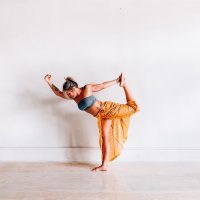View this post on Instagram
The days are getting longer, the sun is getting stronger, and it is also getting harder for me to commit to a yoga class inside a studio.
Luckily, we can take our yoga practice with us anywhere, whether it’s to help us through a stressful moment at work or to get a deep stretch at the gym. We can even take our practice into the water with stand-up paddleboard yoga (SUP).
The familiar yoga poses, no matter how many times we have done them, will feel new on a board, and it may even teach us a new body alignment that we haven’t noticed before.
It might feel a little intimidating to be practicing on the water, but if we go into it with a sense of playfulness, a lot of those scary feelings vanish and are replaced with a “summer vacation” feeling.
When I first took an SUP yoga class, my biggest fear was falling into the water. Now, if I fall in, it’s just proof I am having fun. The worst that can happen is I get wet, which feels nice on a hot, summer day anyway.
Yoga can sometimes get a little competitive, or even heavy, in a studio with mirrors surrounding me. Yoga on my board brings more freedom and even joy to my practice. It really is about having fun.
Remember, we are doing yoga in our bathing suits on a paddleboard. There is nothing to take too seriously.
Below is a series of poses that are easy to do on the water, even for those of us who are totally new to SUP yoga. The poses can stand alone, or they can be strung together if you choose to link them with your breath.
Child’s Pose (Balasana)
Just as many yoga classes start from this humble spot, the SUP practice starts here, too.
You will have the chance to ground onto your board, aligning your belly above the handle. Your head faces toward the nose of the board, and your toes toward the rail.
Take a moment to find some gentle movement in your body, rocking your forehead and hips side to side. As you rock, notice the water beneath as well. Feel that sense of movement as you find stillness in your own body.
Notice the slick board underneath your fingertips and shins. Let the sun start to warm the muscles on your back, as you soften and become heavy. Stay for at least five breaths.
Cat/Cow (Marjaiasana)
Transition to all fours, bringing your belly over the handle. Stack your shoulders over wrists and hips over knees.
In this stable pose, begin to play a bit with your sense of stability. Most practitioners are surprised when they realize just how stable their board is. It actually takes a lot to tip it, and once you have that trust in the support underneath you, your practice can become a little more fun.
Shift your weight from side to side, and maybe even shake or wiggle the board a little bit. You’ll see that it takes quite a lot for the board to move. With this confidence in your stability, you can move happily into Cat/Cow.
Inhale, shine your heart through your shoulders, and reach your beautiful face to the sun. As you exhale, arch your back, and gaze at your navel. You might even see the shoreline behind you. Take your time to enjoy that moment.
This is a wonderful place to stay, flowing with your breath. If you want to add on a layer of core work, you can play with extending your right leg behind you, and perhaps your left arm in front. Press firmly into your board with your left knee and right hand, and notice how this might feel different from being on the floor. Try it on the other side too.
Embrace the wobble. Remember, the worst that can happen is you get to go swimming!
Downward Dog (Adho Mukha Svanasana)
Your first inversion on the board!
With your heart over your head, you can experience the healing benefits of an inversion practice, while still staying stable on the water. Maybe like me, you are not ready for a headstand on your board, yet. But, Down Dog will get you many of the same benefits!
Again, belly aligns with the handle. Nod your head yes and no, and let go of any tension in your neck. While keeping each hand and arm pressing equally into the board, you can experiment with lifting one leg to the sky, and then the other. Stay for five breaths.
Mountain Pose (Tadasana)
This pose always feels like an opportunity to breathe into your power and to experience the sensation of standing on your own two feet. But in the water, it can be even more empowering.
Align the handle between your two feet. Again, a wider stance can be helpful for balance. You can take your gaze to the horizon, or even challenge your balance by looking up toward the sky. As you stand tall with a proud chest and open heart, mentally scan your body for places you might be holding stress. Are there parts of your body that might be working overtime, that could do better by simply relaxing?
Many paddlers will unintentionally clench their toes or feet on the sup board, but tight toes and locked out knees will not help you balance. The shoulders and jaw also tend to be tight, so take a moment to add some softness into your upper body.
Stand tall and breathe.
Smile.
You are doing yoga in the water!
~










Read 2 comments and reply